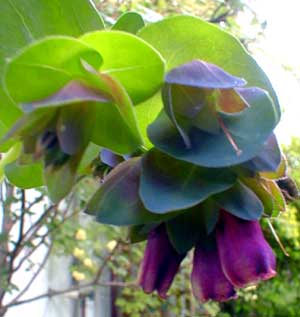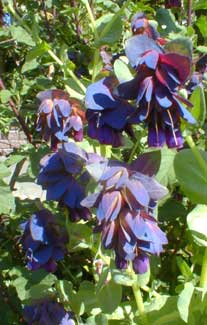
Blue Honeywort; aka,
Blue Wax Flower
"How gloomy the whole day has been!
But here is home. The garden shines."
-Maurice Thompson
(1844-1901)
(1844-1901)
Granny Artemis & I first saw this plant in a display garden where it was growing in dry semi-shade (though it is in general a full-sun plant). We didn't know what it was & we puzzled over possibilities: Some obscure type of euphorbia? A bizarre shrubby honeysuckle?
Eventually we found Cerinthe major var purpurascens for sale. Shortly after placement in our garden in 2003, it dried out & died to the ground, as this is a plant highly susceptible to transplant shock. But within a couple weeks it was growing back, & had a new flush of fresh leaves & a few dangling blue flowers in August. Its second year it was blooming by April & continued to do so through the whole of September, so a good everbloomer.
 The close-up photo at top of the page is from early May (2004) but could as easily have been taken just about any time up through September. The picture captures a tendency for the blue-green leaves behind the purple bracts to take on purple hues as they age. The second photo is from the following April (2005).
The close-up photo at top of the page is from early May (2004) but could as easily have been taken just about any time up through September. The picture captures a tendency for the blue-green leaves behind the purple bracts to take on purple hues as they age. The second photo is from the following April (2005).It had been kind of a floppy flimsy dud in the garden throughout that first year, but the plants we've had since were from the seeds we collected or which planted themselves, & they've never been floppy, though seedlings have to be transplanted very small to avoid a period of slovenly appearance form the shock.
For its second spring, it was like a completely different plant. It struggled through its first winter very uninteresting, practically laying on the ground, then come spring, it shot right up to a sturdy four foot height. Its leaves were twice the size of the previous year. The whole huge plant spread out many arms like an octopus, every arm ending in blue bracts & flowers.
It is sometimes classified as a half-hardy annual, elsetimes as a tender yet evergreen perennial, & still other times as a very hardy though shortlived perennial or biennial. In the Northwest, given the best winter drainage & a moist summer sun location, it can succeed as a perennial.
In the case of our original specimen, it had to come back a second year to be really splendid, but we have since discovered that grown from seeds it looks very nice even its first year. If an individual plant does not last for many years, this hardly matters, because it self-seeds willfully.
It looks like we're going to have it in our garden forever, & I'm glad of it, since I find it interesting, odd, pretty, & perpetually in flower spring through autumn. However, it gets so large that it has been relegated to roadside locations at the fringe of a rugosa garden. A garden of much larger proportions would find it suited to a back border or amidst other huge perennial herbs.
Seedlings can pop up as a dense groundcover in September. These will be appear almost like succulent sedums through winter, then grow enormous in spring, so it will be necessary to thin them down at some point before winter's end. An older plant can look woody & less pleasant, but there are always new ones seeded whenever its time to discard an old one.
For a plant that some gardeners report as tender, it has been like a weed for us. Zone 8 seems to suit it quite fine, & it doesn't care if its in sun, part shade, or in moist soil, or dry soil. It rarely requires staking, but it does need room to stretch its "arms."
Blue Honeywort has only been in American nurseries since about 1997 or 8, & doesn't seem ever to have become a common offering around here, perhaps because it is believed to be tender in our zone. When it does turn up, however, it sells out of stocks rapidly & is never available long at a stretch.
The species, however, is not really new to gardening, since John Gerard's sixteenth century Herbal notes that it was grown for the pleasure of sipping the honey from the flowers. Yet it afterward vanished from English gardens. It was ignored for a couple of centuries, probably because it provided insufficient rewards. It was perhaps a bit too ordinary-looking until the variety "Purpurescens" turned up, which was so improved for looks that the species was bound to make a come-back.
The leaves are a faintly mottled blue-green, ending in nodding blue bracks embracing blue-purple petals. Honeywort bell-flowers are long-lasting in the garden or for bouquets. They are nectar-rich & visited continuously by honeybees & occasionally by hummingbirds.
Though native of the Mediterranean, they do survive in zones with cooler temperatures, where winters get down to zero degrees. They persist through winter in our zone, but will die back in cooler zones. Even if an initial clump fails to perennialize, with a little luck it will have self-seeded before it experiences winter death.
The black seeds are rather large, the size of B-B's. The parent plant "explodes" the seeds a considerable distance. In zones that do not get too terribly cold, the seeds will overwinter in the soil & pop up in spring very reliably. But we discovered that the first spring flowers are already going to seed by mid-summer, & will be well up & attractive fat-leafed seedlings by summer's end. Both the summer/autumn seedlings & the following spring seedlings will be far-scattered, so will need to be be dug up wherever not wanted, & replanted if there is sufficient room.
Gardeners who are set up to produce their own seedlings will want to collect the seeds to start in greenhouses or indoors. The seeds do not ripen together or at a predictable time because it flowers April through September (at minimum) with seeds continuously ripening. They can be impossible to find once the parent plant scatters them about. The recommendation then is to collect the seeded branches into a bouquet, but wrap them in cheese-cloth to dry as they finish ripening, then when the pods burst open the seeds will be right there inside the cloth.
We also discovered that discarding branches with black seeds attached pretty much guaranteed lots & lots of seedlings appearing in the area where branches were discarded. This is actually how what is now our main area for them got started on the roadside.